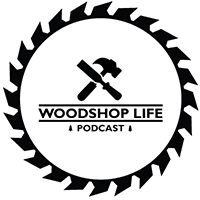Support us on Patreon: https://www.patreon.com/woodshoplife
Guy
1) Next question: how much time do you spend working on workflow and process in the shop? I’m a night and weekend woodworker who is taking commission orders now and want to ensure I maximize my time in the shop to be the most effective. What are some tips tricks or source material you might suggest? Maybe Guy can lend an answer to this, as he is working in a full time production shop. Also, just down the road from you Guy, in Noblesville. Thanks in advance! -Thelibertycraftsman
2) Hi Guy, love the podcast. I have a question about the Festool Kapex. I’m about to purchase a new miter saw and am between the Kapex or the Bosch glider. The only concern I have are some of the comments about the handle shape on the Kapex. Since you use it I’d like your opinion. It is expensive and want to be sure it’s worth it. I would really like a precision miter saw. Thanks you all and love the show. Anthony
Sean
1) I have the opportunity to get my hands on some ash trees that will be felled due to the emerald ash borer. I will have these trees slabbed and kiln dried by a local sawmill.
I am fairly new to woodworking and I am primarily a hand tool user.
My question for you guys is what are your thoughts on using ash to build either a Roubo style workbench. Is ash dense/heavy enough to be used as workbench.
Any feedback is greatly appreciated. Carlos @alberto_woodworks
2) Have you ever heard of anyone hiring someone for a weekend to come to your house and help make adjustments on multiple machines? My tablesaw, bandsaw, jointer and planer all work but could benefit from someone with experience double checking things and making minor adjustments. I know that every machine has its own quirks so finding someone that knows my exact models would be difficult but I feel as though someone with more experience could make a big impact in a short period of time.
Any thoughts or suggestions would be greatly appreciated. – Evan
Huy
1) Hey guys my name is Anthony S. I am a novice woodworker with a focus on medieval furniture for the house and camp as my wife and I are part of a living history group. We are looking for our first house. I would like to have one area of the house for a workshop. I use quite a few power tools in my work now and will hope to get a tablesaw and drill press after the house. I know I should be concerned with ventilation and dust collection, which will be determined by where in the house the workshop is, but I am hoping for it to be in the garage. I was wondering what else should we be looking for in a workshop space when house hunting.
2) I have a chance to buy a second hand Felder AF22 dust extractor. It is a 2.2kw 3HP machine but it has a three phase motor in it (I’m in the UK). Putting in three phase power is prohibitively expensive.
Do you have any experience of running a three phase machine with a VFD (preferably an inexpensive Chinese one) and can I use a remote control switch to activate it from my table saw. Many thanks, Mark
Information mentioned in the podcast from Huy: Acogedor AC 220V 2.2KW VFD Motor Inverter Speed Controller,Variable Frequency Drive with Wireless Remote Control
